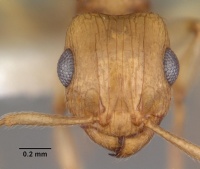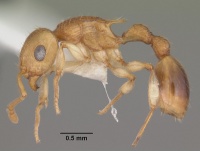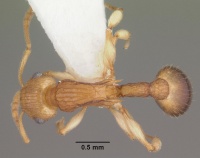Rotastruma
| Rotastruma | |
|---|---|

| |
| Rotastruma recava | |
| Scientific classification | |
| Kingdom: | Animalia |
| Phylum: | Arthropoda |
| Class: | Insecta |
| Order: | Hymenoptera |
| Family: | Formicidae |
| Subfamily: | Myrmicinae |
| Tribe: | Crematogastrini |
| Alliance: | Paratopula genus group |
| Genus: | Rotastruma Bolton, 1991 |
| Type species | |
| Rotastruma recava | |
| Diversity | |
| 3 species (Species Checklist, Species by Country) | |
Luo and Guénard (2016) - Rotastruma is a rarely collected arboreal genus with two species. They exhibit a limited distribution in the Indomalayan region. Rotastruma recava is known from Borneo and the Malaysian Peninsula, and Rotastruma stenoceps is reported from China (Hubei, Hunan, Guangdong, Yunnan) (antmaps.org). The latter was described in 1991 from Guangdong (China) on the basis of the worker caste, with virtually no information reported on its ecology since its original description. Recently, during attempts to collect additional Paratopula specimens, a single queen identified as Rotastruma stenoceps was collected in Hong Kong, less than 200 kilometres South East from the site of the holotype (Bolton 1991).
Identification
Rotastruma is a marginal leptothoracine genus. It falls into an assemblage of small and little-understood genera on the periphery of what is currently understood as tribe Leptothoracini. Rotastruma appears to have affinities with the genera Paratopula and Romblonella, which form part of this marginal group. Little more can be said of this enigmatic small genus until a detailed survey can be made to define with some accuracy where the limits of tribe Leptothoracini really lie. The respective species pages of the ants that comprise this genus explain how to identify the two known species.
Keys including this Genus
Keys to Species in this Genus
Distribution
Southern China, Singapore and Sarawak (East Malayasia).
Distribution and Richness based on AntMaps
Species by Region
Number of species within biogeographic regions, along with the total number of species for each region.
| Afrotropical Region | Australasian Region | Indo-Australian Region | Malagasy Region | Nearctic Region | Neotropical Region | Oriental Region | Palaearctic Region | |
|---|---|---|---|---|---|---|---|---|
| Species | 0 | 0 | 1 | 0 | 0 | 0 | 1 | 1 |
| Total Species | 2841 | 1736 | 3045 | 932 | 835 | 4379 | 1741 | 2862 |
Biology
Little is known about the two species of Rotastruma. R. recava has been collected from dead twigs. R. stenoceps is only known from the types and there are no habitat or other biological details associated with their collection.
Hosoishi et al. (2015) collected one colony of an uncertain Rotastruma sp. in regrowth forest in Kampong Thom Province, Cambodia. Two species are currently recognised: Rotastruma recava from Singapore and Borneo, and Rotastruma stenoceps from China (Bolton, 1991). According to a key to species (Bolton, 1991), the collected specimens are similar to R. stenoceps in having the occipital margin transverse and sides of head straight, but differ slightly by having propodeal spines curving upward.
Life History Traits
- Mean colony size: ? (Greer et al., 2021)
- Compound colony type: not parasitic (Greer et al., 2021)
- Nest site: arboreal (Greer et al., 2021)
- Diet class: ? (Greer et al., 2021)
- Foraging stratum: arboreal (Greer et al., 2021)
Castes
Morphology
Worker Morphology
 Explore: Show all Worker Morphology data or Search these data. See also a list of all data tables or learn how data is managed.
Explore: Show all Worker Morphology data or Search these data. See also a list of all data tables or learn how data is managed.
• Antennal segment count: 12 • Antennal club: 3 • Palp formula: 5,3 • Spur formula: 0, 0 • Eyes: 11-100 ommatidia • Pronotal Spines: absent • Mesonotal Spines: absent • Propodeal Spines: present • Petiolar Spines: absent • Caste: none or weak • Sting: present • Metaplural Gland: present • Cocoon: absent
Male Morphology
 Explore: Show all Male Morphology data or Search these data. See also a list of all data tables or learn how data is managed.
Explore: Show all Male Morphology data or Search these data. See also a list of all data tables or learn how data is managed.
• Caste unknown
Phylogeny
| Myrmicinae |
| ||||||||||||||||||||||||||||||||||||||||||||||||||||||||||||||||||||||||||||||||||||||||||||||||||||||||||||||||||||||||||||||||||||||||||||||||||||||||||||||||||||||||||||||||||||||||||||||||||||||||||||||||||||||||||||||||||||||||||||||||||||||||||||||||||||||||||||||||||||||||||||||||||||||||||||||||||||||||||||||||||||||||||||||||||||||||||||||||||||||||||||||||||||||||||||||||||||||||||||||||||||||||||||||||||||||||||||||||||||||||||||||||||||||||||||||||||||||||||||||||||||||||||||||||||||||||||||||||||||||||||||||||||||||||||||||||||||||||||||||||||||||||||||||||||||||||||||||||||||||||||||||||||||||||||||||||||||||||||||||||||||||||||||||||||||||||||||||||||||||||||||||||||||||||||||||||||||||||||||||||||||||||||||||||||||||||||||||||||||||||||||||||||||||||||||||||||||||||||||||||||||||||||||||||||||||||||||||||||||||||||||||||||||||||||||||||||||||||||||||||||||||||||||||||||||
See Phylogeny of Myrmicinae for details.
Nomenclature
The following information is derived from Barry Bolton's Online Catalogue of the Ants of the World.
- ROTASTRUMA [Myrmicinae: Formicoxenini]
- Rotastruma Bolton, 1991: 8. Type-species: Rotastruma recava, by original designation.
Unless otherwise noted the text for the remainder of this section is reported from the publication that includes the original description.
Worker Monomorphic subarboreal to arboreal myrmicine ants with the following combination of characters.
1. Palp formula 5, 3.
2. Mandible triangular, with 6 teeth which decrease in size from apical to basal.
3. Clypeus with a median longitudinal carina; anterior clypeal margin with a pair of hairs which straddle the midpoint.
4. Median portion of clypeus broad posteriorly, broadly inserted between the frontal lobes.
5. Frontal lobes narrow, each lobe distinctly narrower than the portion of the clypeus that is inserted between them.
6. Torulus not freely projecting.
7. Frontal carinae very weakly present; antennal scrobes represented only by extremely shallowly depressed areas running above the eyes.
8. Eyes large, situated at or just behind the midlength of the sides.
9. Antennae 12-segmented, the 3 apical segments forming a strongly defined club.
10. Alitrunk low in profile and with a shallowly evenly convex dorsum; promesonotum not domed-convex; metanotal groove absent; propodeum bispinose; sides of alitrunk marginate, especially on mesonotum and propodeum.
11. Propodeal spiracle set low on the side at about the midlength of the sclerite, very close to the dorsalmost point of the metapleural gland bulla.
12. Metapleural lobes present, small and rounded.
13. Metasternal process absent; cuticle between anterior halves of metacoxal cavities depressed.
14. Tibial spurs absent from middle and hind legs.
15. Petiole nodiform, with a short anterior peduncle; petiolar spiracle located at about the midlength of the peduncle.
16. Postpetiolar sternite reduced, small in profile.
17. Sting functional, strong and simple.
18. Cuticle thick and armoured. Pilosity present on all dorsal surfaces of head and body.
Female As worker but only very slightly larger in size. Ocelli present. Alitrunk with full complement of flight sclerites and certainly winged when virgin.
References
- Blaimer, B.B., Ward, P.S., Schultz, T.R., Fisher, B.L., Brady, S.G. 2018. Paleotropical diversification dominates the evolution of the hyperdiverse ant tribe Crematogastrini (Hymenoptera: Formicidae). Insect Systematics and Diversity 2(5): 3; 1-14 (doi:10.1093/isd/ixy013).
- Bolton, B. 1991. New myrmicine genera from the Oriental Region (Hymenoptera: Formicidae). Syst. Entomol. 16: 1-13. (page 8, Rotastruma as genus; Rotastruma in Myrmicinae, Leptothoracini)
- Bolton, B. 1994. Identification guide to the ant genera of the world. Cambridge, Mass.: Harvard University Press, 222 pp. (page 105, Rotastruma in Myrmicinae, Formicoxenini)
- Bolton, B. 1995a. A taxonomic and zoogeographical census of the extant ant taxa (Hymenoptera: Formicidae). J. Nat. Hist. 2 29: 1037-1056 (page 1052, Rotastruma in Myrmicinae, Formicoxenini)
- Bolton, B. 1995b. A new general catalogue of the ants of the world. Cambridge, Mass.: Harvard University Press, 504 pp. (page 382, Rotastruma in Myrmicinae, Formicoxenini)
- Bolton, B. 2003. Synopsis and Classification of Formicidae. Mem. Am. Entomol. Inst. 71: 370pp (page 252, Rotastruma in Myrmicinae, Formicoxenini)
- Cantone S. 2018. Winged Ants, The queen. Dichotomous key to genera of winged female ants in the World. The Wings of Ants: morphological and systematic relationships (self-published).
- Hosoishi, S., Yamane, S., Sokh, H. 2021. A third species of the rare ant genus Rotastruma (Hymenoptera, Formicidae) from Cambodia, with illustrated generic diagnoses and key to species. Deutsche Entomologische Zeitschrift 68, 225–233 (doi:10.3897/dez.68.63478).
- Kreider, J.J., Chen, T.W., Hartke, T.R., Buchori, D., Hidayat, P., Nazarreta, R., Scheu, S., Drescher, J. 2021. Rainforest conversion to monocultures favors generalist ants with large colonies. Ecosphere 12 (doi:10.1002/ecs2.3717).
- Luo, Y.Y. and Guénard, B. 2016. Descriptions of a new species and the gyne in the rarely collected arboreal genera Paratopula and Rotastruma (Hymenopytera: Formicidae) from Hong Kong, with a discussion on their ecology. Asian Myrmecology. 8:1-16. doi:10.20362/am.008016

